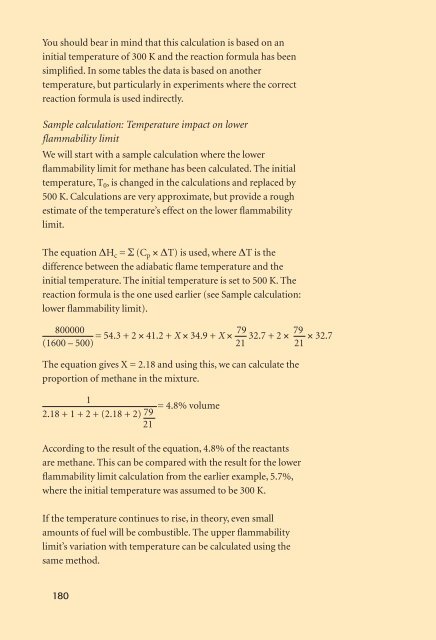You also want an ePaper? Increase the reach of your titles
YUMPU automatically turns print PDFs into web optimized ePapers that Google loves.
You should bear in mind that this calculation is based on an<br />
initial temperature of 300 K and the reaction formula has been<br />
simplifi ed. In some tables the data is based on another<br />
temperature, but particularly in experiments where the correct<br />
reaction formula is used indirectly.<br />
Sample calculation: Temperature impact on lower<br />
fl ammability limit<br />
We will start with a sample calculation where the lower<br />
fl ammability limit for methane has been calculated. The initial<br />
temperature, T 0, is changed in the calculations and replaced by<br />
500 K. Calculations are very approximate, but provide a rough<br />
estimate of the temperature’s effect on the lower fl ammability<br />
limit.<br />
The equation DH c = S (C p × DT) is used, where DT is the<br />
difference between the adiabatic fl ame temperature and the<br />
initial temperature. The initial temperature is set to 500 K. The<br />
reaction formula is the one used earlier (see Sample calculation:<br />
lower fl ammability limit).<br />
800000 = 54.3 + 2 × 41.2 + X × 34.9 + X × 79 32.7 + 2 × 79 × 32.7<br />
(1600 – 500) 21 21<br />
The equation gives X = 2.18 and using this, we can calculate the<br />
proportion of methane in the mixture.<br />
1 = 4.8% volume<br />
2.18 + 1 + 2 + (2.18 + 2) 79<br />
21<br />
According to the result of the equation, 4.8% of the reactants<br />
are methane. This can be compared with the result for the lower<br />
fl ammability limit calculation from the earlier example, 5.7%,<br />
where the initial temperature was assumed to be 300 K.<br />
If the temperature continues to rise, in theory, even small<br />
amounts of fuel will be combustible. The upper fl ammability<br />
limit’s variation with temperature can be calculated using the<br />
same method.<br />
180

















